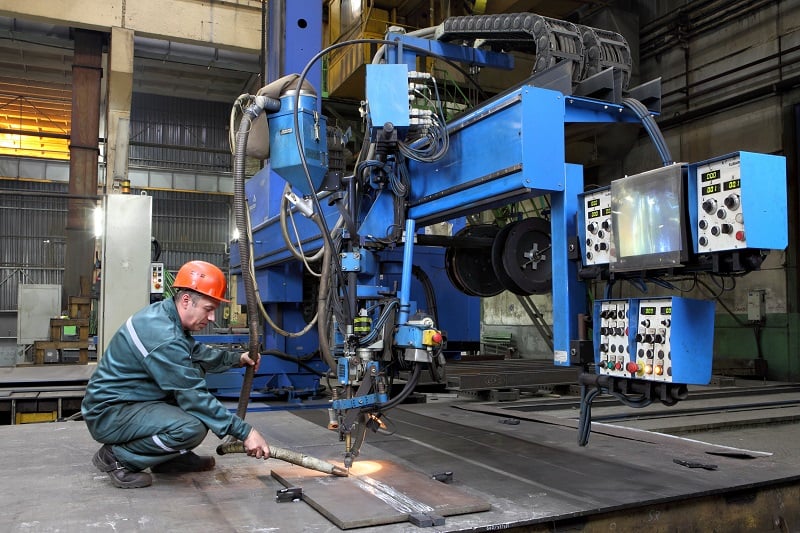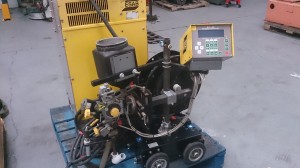As specialist dealers in used submerged arc welding equipment, we always want to buy more!
Equipment for submerged arc welding.
The submerged-arc welding (SAW) process is similar to MIG, where the arc is formed between a continuously-fed wire electrode and the work piece. The weld is then formed by the arc melting the work piece and the wire.
However in SAW, a shielding gas is not required, as the layer of flux generates the gases and slag to protect the weld pool and hot weld metal from contamination.
Flux plays an additional role in adding alloying elements to the weld pool.
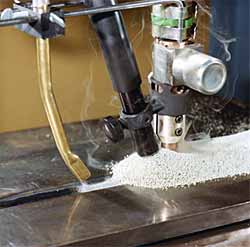
Essential equipment components for SAW are:
- Power source
- SAW head
- Flux handling
- Protective equipment
As SAW is a high current welding process, the equipment is designed to produce high deposition rates.
Compliments of Welding Specialists Arc Energy Resources of England.
Brands:
ESAB, Lincoln Electric, Miller Welding, Fronius, Gullco and SAF
What we do:
We buy and sell all associated equipment to sub-arc welding . Including power sources, column and boom manipulators, pipe rotators, welding tractors, welding positioners, flux hoppers and accessories. All of our equipment is prepared to order.
Power source.
SAW can be operated using either a DC or an AC power source. DC is supplied by a transformer-rectifier and AC is supplied by a transformer.
Current for a single wire ranges from as low as 200A (1.6mm diameter wire) to as high as 1000A (6.0mm diameter wire).
In practice, most welding is carried out on thick plate where a single wire (4.0mm diameter) is normally used over a more limited range of 600 to 900A. With a twin wire system operating between 800 and 1200A.
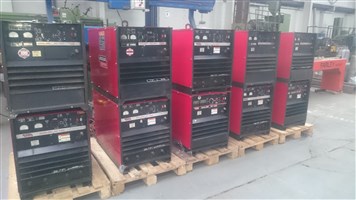
DC Sub Arc Welding.
In DC operation, the electrode is normally connected to the positive terminal. Electrode negative (DCEN) polarity can be used to increase deposition rate, but depth of penetration is reduced by between 20 and 25%. For this reason, DCEN is used for surfacing applications where parent metal dilution is important. The DC power source has a ‘constant voltage’ output characteristic, which produces a self-regulating arc. For a given diameter of wire, welding current is controlled by wire feed speed and arc length is determined by voltage setting.
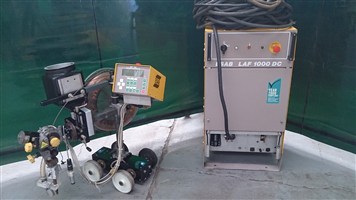
AC Sub Arc Welding.
AC power sources usually have a constant-current output characteristic, and are therefore not self-regulating.
The arc with this type of power source is controlled by sensing the arc voltage, and using the signal to control wire feed speed. In practice, for a given welding current level, arc length is determined by wire burn-off rate. I.e., the balance between the welding current setting and wire feed speed which is under feedback control.
Squarewave Technology.
AC squarewave power sources have a constant voltage output current characteristic. Advantages are easier arc ignition and constant wire feed speed control.
Welding Gun.
SAW can be carried out using both manual and mechanised techniques. Mechanised welding, which can exploit the potential for extremely high deposition rates, accounts for the majority of applications.
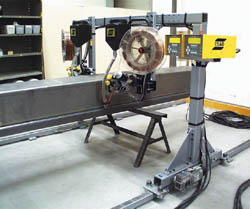
Manual Welding.
For manual welding, the welding gun is similar to a MIG gun. The flux, which is fed concentrically around the electrode, replaces the shielding gas. Flux is fed by air pressure through the handle of the gun or from a small hopper mounted on the gun.
The equipment is relatively portable and, as the operator guides the gun along the joint, little manipulative skill is required.
However, because the operator has limited control over the welding operation (apart from adjusting travel speed to maintain the bead profile), it is best used for short runs and simple filling operations.
Mechanised Welding – Single Wire.
As SAW is often used for welding large components, the gun, wire feeder and flux delivery feed can be mounted on a rail, tractor or boom manipulator.
Single wire welding is mostly practised using DCEP, even though AC will produce a higher deposition rate for the same welding current.
AC is used to overcome problems with arc blow, caused by residual magnetism in the workpiece, jigging or welding machine.
Parameters.
Wire stickout, or electrode extension – the distance the wire protrudes from the end of the contact tip – is an important control parameter in SAW.
As the current flowing between the contact tip and the arc will preheat the wire, wire burnoff rate will increase with increase in wire stickout. For example, the deposition rate for a 4mm diameter wire at a welding current of 700A, can be increased from approximately 9 kg/hr at the normal 32mm stickout, to 14 kg/hr at a stickout length of 178mm.
In practice, a long stickout is normally only used in cladding and surfacing applications where there is greater emphasis on deposition rate and control of penetration. As opposed to accurate positioning of the wire, due to the reduction in penetration and greater risk of arc wander.
Multi-wire Sub Arc Welding.
SAW can be operated with more than one wire. Although up to five wires are used for high deposition rates, e.g. in pipe mills, the most common multi-wire systems have two wires in a tandem arrangement. The leading wire is run on DCEP to produce deep penetration. The trailing wire is operated on AC which spreads the weld pool, which is ideal for filling the joint.
AC also minimises: interaction between the arcs, and the risk of lack of fusion defects and porosity through the deflection of the arcs (arc blow).
The wires are normally spaced 20mm apart so that the second wire feeds into the rear of the weld pool.
Gun Angle.
In manual welding, the gun is operated with a trailing angle, i.e. with the gun at an angle of 45 degrees (backwards) from the vertical. In single wire mechanised welding operations, the gun is perpendicular to the workpiece.
However, in twin wire operations the leading gun is normal to the workpiece, with the trailing gun angled slightly forwards between an angle of 60 and 80 degrees. This reduces disturbance of the weld pool and produces a smooth weld bead profile.
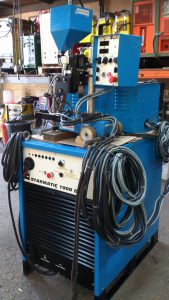
Flux Handling.
Flux should be stored in unopened packages under dry conditions. Open packages should be stored in a humidity-controlled store.
While flux from a newly-opened package is ready for immediate use, flux which has been opened and held in a store should first be dried according to manufacturer’s instructions.
In small welding systems, flux is usually held in a small hopper above the welding gun. It is fed automatically (by gravity or mechanised feed) ahead of the arc.
In larger installations the flux is stored in large hoppers and is fed with compressed air.
Unused flux is collected using a vacuum hose and returned to the hopper.
Protective Equipment.
Unlike other arc welding processes, SAW is a clean process which produces minimum fume and spatter when welding steels. (Some noxious emissions can be produced when welding special materials.)
For normal applications, general workshop extraction should be adequate.
Protective equipment such as a head shield and a leather apron are not necessary.
Normal protective equipment (goggles, heavy gloves and protective shoes) are required for ancillary operations such as slag removal by chipping or grinding.
Special precautions should be taken when handling flux – a dust respirator and gloves are needed when loading the storage hoppers.
Have you surplus sub arc welding equipment to dispose of? Westermans will handle inspections, payment and collection quickly and always pay great prices for the latest models.
Please contact our Buying Team with any surplus SAW plant. We pay commission on successful leads too so it doesn’t have to be your stock.
For our full range of submerged arc welding equipment for sale today follow this link to our website. Or call our Sales department to discuss. We specialise in selling bespoke packages worldwide.
If you have enjoyed reading this Blog, why not Register for our newsletter or better still suggest some topics we can cover.
Remember USED equipment offers quality without a high price tag and well worth considering for your next project.
